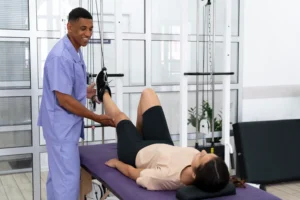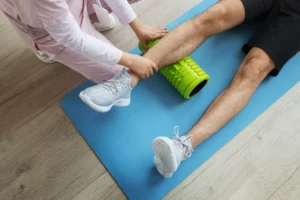What Do You Wear to a Physical Therapy Appointment?
Wearing the right clothing to a physical therapy appointment is a bit more important than you may think. It helps you move more freely and allows your therapist to access different treatment areas. Tight or restrictive clothes can make exercises or manual therapy more difficult. So what to wear to physical therapy?
Why Clothing Choice Matters for Physical Therapy
Clothing choice matters in how comfortable and effective your physical therapy session will be. The right outfit helps your therapist to observe your posture, joint movement, and alignment clearly. It also makes it easier to perform stretches, exercises, or hands-on techniques safely. Wearing appropriate clothing helps both you and your therapist make the session more efficient. Loose, breathable clothing can help you feel more free during active movements, while fitted items like athletic shorts or tank tops give your therapist better access to specific joints or muscles. All in all, the right gear is great for both your comfort and your recovery.
General Guidelines for Physical Therapy Attire
- Wear Comfortable, Breathable Clothing. Choose something lightweight and loose-fitting. Breathable fabrics like cotton or performance materials help you stay cool and comfortable during movement and stretching.
- Dress in Layers. Physical therapy spaces can have different temperatures. Layering a light sweatshirt or jacket over a T-shirt or tank top makes it easy to adjust if you feel too warm or too cold.
- Avoid Restrictive Outfits. Tight jeans, bulky sweaters, or skirts can limit your movement and make certain exercises more difficult – or even unsafe.
- Opt for Athletic Wear. When you think of what to wear to physical therapy, think of what you’d wear to a gym. Items like gym shorts, yoga pants, T-shirts, or tank tops are all good options.
- Function Over Style. While it’s natural to want to look well put-together, you should focus more on function. Skip physical therapy outfits with complicated zippers, buttons, or accessories that might dig in or shift during movement.
- Consider the Area Being Treated. When you think of what to wear to physio If you’re attending therapy for a specific area – like your knee, shoulder, or hip – wear clothing that makes it easy to expose or move around that area. For example, shorts for knee work or a sleeveless top for shoulder exercises are the best picks.
What to Wear to Physical Therapy Based on Body Area
What to wear to physiotherapy? Choosing the right clothing can also vary depending on what part of your body is being treated. While general comfort is important, certain body areas may require more specific outfit choices to give your therapist access and make it easier to work with them. Below, we’ll give you some practical suggestions about what to wear to a physio appointment based on different treatment zones, so you can show up prepared.
What to Wear for Back Therapy
What to wear to physical therapy for back? Wear a loose-fitting T-shirt and a supportive sports bra to have full access to the spine and upper back. Pair this with comfortable shorts or workout pants that have an elastic waistband. This makes it easier for your therapist to assess and treat the muscles while allowing you to move freely during sessions. Avoid bulky layers or tight tops, as they can make movement more difficult.
What to Wear for Knee Therapy
What to wear to physical therapy for knee? For knee therapy, choose clothing that gives your therapist full access to the joint. Shorts are ideal, but loose workout pants that can be pulled up above the knee are also good. This makes it easier for your therapist to observe movement and apply manual techniques. Avoid anything tight or restrictive around the knees, like leggings or jeans.
What to Wear for Hip Therapy
What to wear to physical therapy for hip? For hip therapy sessions, wear flexible athletic shorts or pants with an elastic waistband that make movement easier. Your therapist needs to observe and move the hip joint freely, so avoid clothing that’s too long, stiff, or tight. Ideally, your outfit should also allow visibility of your lower back and spine, as hip mobility is often assessed alongside surrounding areas. Breathable, stretchy fabrics are both comfortable and best suitable for sessions.
What to Wear for Shoulder & Neck Therapy
What to wear to physical therapy for neck and shoulder pain? For shoulder and neck therapy, choose a loose-fitting T-shirt or tank top that allows full access to your upper back, shoulders, and neck. Women may find it helpful to wear a sports bra with a racerback or open-shoulder design. Don’t wear hoodies or high-collared shirts, as they are bad for visibility and movement. The goal is to let your therapist assess posture, movement, and muscle tension without fabric getting in the way.
What to Wear for Leg or Sciatica Therapy
What to wear to physio for sciatica? For leg or sciatica therapy, wear flexible athletic shorts or lightweight sweatpants that don’t restrict movement. The fabric should allow your therapist to observe and access the full leg, including the lower back and buttock area where sciatic pain may come from. Don’t use jeans or thick materials that can make movement more difficult. Choose clothing with an elastic waistband to make stretching, walking drills, or manual therapy focused on nerve and muscle function in the legs and lower back easier.
Proper Footwear for Physical Therapy
Wearing the right shoes to your physical therapy appointment isn’t just a small detail – it’s as important for your treatment as proper physical therapy attire. Athletic sneakers or flat-soled trainers with good grip are your best choice. They make foot movement natural and reduce the risk of slipping or strain during therapy tasks.
If you recently switched shoes, bring your older pair too. Therapists may want to understand your gait or how you distribute weight. This can offer insight into underlying issues or injury risks. Avoid open-toed shoes, heels, or anything without proper arch support – these can make your movement and sessions less efficient. Your footwear tells part of your health story – make sure it’s the right one.
Tips for Your First Physical Therapy Session
- What to bring. Bring your insurance card, ID, referral if required, and a list of any medications or prior injuries. If your pain is related to certain gear or shoes, bring them too so the therapist can evaluate them.
- How to prepare. Dress in comfortable, loose clothing suited to your treatment area. You’ll be moving, so choose outfits you can stretch and bend in easily. Try to arrive on time or a bit early to fill out any forms and settle in.
- What hairstyle to wear. If you have long hair and are coming for upper back, neck, or shoulder therapy, wear your hair tied up. This helps keep the treatment area clear and makes it easier for the therapist to work.
- Why you should check the requirements with the physiotherapist in advance. Every injury is different. Some may require clothing that exposes certain body areas or limits on what you can wear or bring. A quick call or message to the clinic beforehand is a very good idea if you don’t want any surprises.
Conclusion
Wearing the right clothes for physical therapy session isn’t just about comfort – it directly affects your treatment. When your therapist can clearly see and access the area being worked on, you’re more likely to get better results. Whether you’re recovering from an injury, working on mobility issues, or want to reduce pain, being prepared helps make every session more efficient.
If you’re seeing a specialist like a chiropractor Libertyville patients trust, or looking for treatment options and wondering can a chiropractor help with plantar fasciitis, these same principles apply. From proper clothes to understanding sports massage benefits, a little preparation goes a long way in making your recovery more efficient.
FAQs About Physical Therapy Outfits
What Should You Wear to a Physical Therapy Appointment if You’re Unsure?
If you’re unsure what to wear, choose loose, stretchy clothes like a T-shirt and athletic shorts or pants. When in doubt, ask your clinic ahead of time for specific recommendations.
Can I Wear Leggings to Physical Therapy?
Sure, you can wear leggings to physical therapy as long as they aren’t too tight or restrictive. Choose breathable, stretchy fabric to stay comfortable during exercises. Just make sure the therapist can easily access the treatment area.
Can I Wear Perfume or Lotion to My Appointment?
It’s best to avoid wearing strong perfumes or scented lotions to your appointment, as they may cause discomfort for others, especially in shared therapy spaces. Unscented lotion is generally fine if it doesn’t interfere with manual treatment or equipment. Always check with your clinic if you’re unsure.
What Not to Wear to Physical Therapy?
Avoid wearing jeans, skirts, tight clothing, or anything that limits movement. High heels, flip-flops, and open-toed shoes are also not recommended.
Should I Bring Extra Clothing or Shoes to My Appointment?
It’s a good idea to bring extra clothing or shoes, especially if your therapist wants to assess your gait or footwear.







